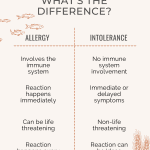Anyone who has eaten something that didn’t agree with them knows it can be an unpleasant, uncomfortable and sometimes scary experience, whether it be due to an allergic reaction, food intolerance or a dose of food poisoning.
While food poisoning is generally well understood, the difference between a food allergy and food intolerance is often confused. Especially these days where food is the first thing to be blamed any time we are experiencing unpleasant symptoms.
So, let’s clear up what is the difference between a food allergy and food intolerance.
What is a food allergy?
Food allergies occur when a person’s immune system mistakes certain foods eaten as being harmful.
The immune system overreacts and produces antibodies called Immunoglobulin E (IgE). These antibodies travel to cells that flood the body with chemicals (such as histamines) that cause unpleasant and scary physical symptoms known as an allergic reaction. Allergic reactions normally come on suddenly and, if left untreated, can be fatal.
Anaphylaxis is the most severe form of allergic reaction and causes symptoms that affect the respiratory, skin, cardiovascular and gastrointestinal systems.
90% of all food-triggered anaphylactic reactions are caused by just ten foods. They are egg, milk, peanuts, tree nuts (e.g., cashews, almonds), fish, shellfish (e.g., prawns and lobster), sesame, soy, wheat and lupins. However, there are many more foods known to have triggered allergic and anaphylactic reactions.
Symptoms of a food allergy:
- Hives, welts or body redness
- Swelling of the face, lips, eyes
- Abdominal pain
- Vomiting
- Tingling/scratchy sensation in the mouth
- Drop in blood pressure
Symptoms of anaphylaxis:
- Symptoms listed above plus;
- Swelling of the tongue
- Swelling in the throat
- Difficult and noisy breathing
- Difficulty talking and/or a hoarse voice
- A wheeze or persistent cough
- Dizziness and possible collapse
- Young children can appear pale and floppy

What is a food intolerance?
Food intolerances (also referred to as food sensitivities) involve the digestive system. There is no immune system involvement. While they can cause extreme discomfort and impact quality of life, food intolerances are not life-threatening like anaphylactic food allergies.
In fact, a lot of people who do have food intolerances can eat small amounts of ‘trigger’ foods without symptoms and symptoms tend to come on gradually (although sometimes it doesn’t feel like that!).
Food intolerances can be caused by:
- The body not making enough enzymes needed to properly digest a food. A common example is lactose intolerance, where people do not produce enough of the enzyme lactase to break the lactose down into galactose and glucose
- Conditions like Irritable Bowel Syndrome
- Sensitivity to food additives
- Sensitivity to naturally occurring chemicals in food such as amines (found in bananas, red wine, chocolate, pineapple) glutamate (found in mushrooms, soy sauce, tomatoes) and salicylates (found in fruit, vegetables, herbs and spices)
Symptoms of food intolerances
The way people experience food intolerances can vary. And some of the symptoms of food intolerances are similar to those of a food allergy, which adds to the confusion between the two.
- Skin rashes or swelling
- Asthma
- Congestion or runny nose
- Irritable bowel symptoms like cramping, bloating, and diarrhoea
- Mouth ulcers
- Hives
- Headache or migraine
- Irritability
- Lethargy

Other types of adverse food reactions
Many more conditions can be flared or exacerbated by eating certain foods. A few examples include:
- Coeliac disease: Coeliac disease does involve the immune system. However, people with Coeliac disease are not at risk of anaphylaxis. Instead, the immune system mounts a response when foods containing gluten are eaten, causing damage to the small intestine’s lining. This damage impacts nutrient absorption (leading to deficiencies) and can cause gastrointestinal symptoms.
- Gastro-oesophageal Reflux Disease (GORD, or GERD): GORD is a condition where stomach acid moves into the oesophagus, irritating the lining and causing pain, burning in the chest, bad breath, burping and pain when swallowing. Citrus, peppermint, chocolate, coffee, alcohol, spicy food are just some of the foods that can flare GORD.
- Rosacea is a facial skin condition. People with rosacea often find that alcohol, spicy food, some fruits and vegetables cause the skin to ‘flare up’.
- Gout is a type of arthritis. ‘Attacks’ of gout are brought on by the consumption of alcohol, meat, offal, shellfish, fructose and foods containing yeast (e.g., Vegemite).
- Food Protein Induced Enterocolitis Syndrome (FPIES): FPIES is a condition that mostly affects babies and children and involves inflammation of the small and large intestines as a result of an allergic reaction to a food eaten.
- Eosinophilic Oesophagitis (EoE): EoE happens when the immune system reacts to certain foods causing eosinophils (a type of white blood cell) to build up in the oesophagus. This build-up of eosinophils can cause reflux, difficulty swallowing, nausea, abdominal and chest pain and in some cases and food getting stuck in the oesophagus.
- Avoidant Restrictive Food Intake Disorder (ARFID): is a clinical eating disorder characterised by very selective eating habits. Eating foods considered ‘unsafe’, or even the thought of eating them, can generate physical symptoms such as constipation, stomach upset and reflux.
Food Labelling
Because of the potential to cause food allergies and anaphylaxis, The Food Standards Code requires foods and food products to declare if they contain any of the Top 10 allergens (peanuts, tree nuts, milk, eggs, sesame, fish, shellfish, lupins, soy and wheat).
Gluten containing cereals (wheat, rye, barley, oats, spelt) and compound ingredients that contain gluten also must be declared on food labels given their potential to cause damage to the gastrointestinal tract of people with Coeliac disease.
Want more on food allergies and intolerances? You might also like:
Tips for eating out with a food allergy
Allergy friendly restaurants in Melbourne

 Hi! My name is Nina.
I’m a Certified Intuitive Eating Counsellor taking the ‘diet’ out of Dietitian. I am here to help you reject diet culture, tune into your body’s own inner wisdom about how to truly nourish yourself and ultimately feel good eating™
Hi! My name is Nina.
I’m a Certified Intuitive Eating Counsellor taking the ‘diet’ out of Dietitian. I am here to help you reject diet culture, tune into your body’s own inner wisdom about how to truly nourish yourself and ultimately feel good eating™ 
